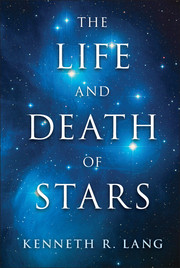Book contents
- Frontmatter
- Contents
- List of Focus Elements
- List of Tables
- Preface
- 1 Light of the Sun
- 2 Gravity and Motion
- 3 Atomic and Subatomic Particles
- 4 Transmutation of the Elements
- 5 What Makes the Sun Shine?
- 6 The Extended Solar Atmosphere
- 7 Comparisons of the Sun with Other Stars
- 8 The Lives of Stars
- 9 The Material Between the Stars
- 10 New Stars Arise from the Darkness
- 11 Stellar End States
- 12 A Larger, Expanding Universe
- 13 Birth, Life, and Death of the Universe
- Quotation References
- Author Index
- Subject Index
- Plate section
12 - A Larger, Expanding Universe
Published online by Cambridge University Press: 05 February 2013
- Frontmatter
- Contents
- List of Focus Elements
- List of Tables
- Preface
- 1 Light of the Sun
- 2 Gravity and Motion
- 3 Atomic and Subatomic Particles
- 4 Transmutation of the Elements
- 5 What Makes the Sun Shine?
- 6 The Extended Solar Atmosphere
- 7 Comparisons of the Sun with Other Stars
- 8 The Lives of Stars
- 9 The Material Between the Stars
- 10 New Stars Arise from the Darkness
- 11 Stellar End States
- 12 A Larger, Expanding Universe
- 13 Birth, Life, and Death of the Universe
- Quotation References
- Author Index
- Subject Index
- Plate section
Summary
Where Does the Milky Way End and How Does It Move?
A Fathomless Disk of Stars
On a clear, moonless night, we can look up and see a hazy, faint luminous band of light that stretches across the sky from one horizon to the other; it is known as the Milky Way (Fig. 12.1). According to ancient Greek myth, the goddess Hera, Queen of Heaven, spilled milk from her breasts into the sky. The Romans called the spilt milk the Via Lactea, or the “Milky Way.” It also is designated as our Galaxy, derived from the Greek word galakt- for “milk,” the celestial milk from Hera's breast.
The Milky Way has been long thought to be a path to the heavens, the road to paradise. In his Metamorphoses, the Roman poet Publius Ovidius Naso (Ovid) described it as a passageway to the homes of the gods. Sixteen centuries later, the English poet John Milton described the Milky Way as a broad and ample road, the dust of which is gold.
We are immersed within the Milky Way, viewing it edgewise from inside. When gazing directly into the band of starlight, we cannot see through to stars at the center or distant edges of the Milky Way, but if we look up and outside the thin disk of stars, we can look beyond them. It is similar to living in a city: We notice buildings all around us but none when we look up into the sky.
When Galileo Galilei turned one of the first telescopes toward the Milky Way, he found that it contains many otherwise unseen stars, which are too faint to be seen by the unaided human eye. Astronomers subsequently built increasingly larger telescopes, which collect more starlight and enable us to see the dim, golden beacons of fainter stars. They discovered more dim stars located between or beyond the brighter ones, which make the Milky Way look like a continuously distributed band of light when observed by the unaided eye.
- Type
- Chapter
- Information
- The Life and Death of Stars , pp. 259 - 286Publisher: Cambridge University PressPrint publication year: 2013



